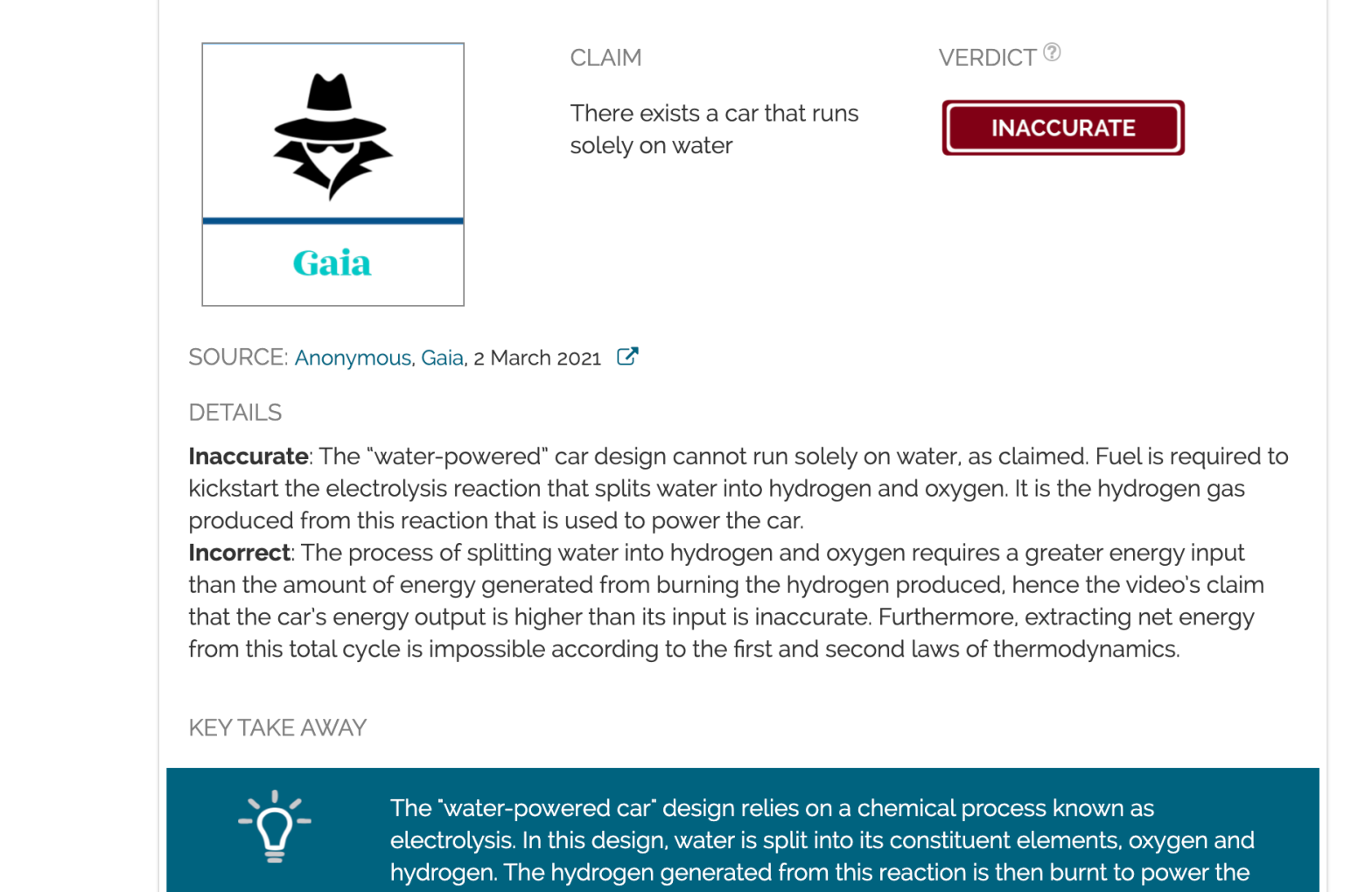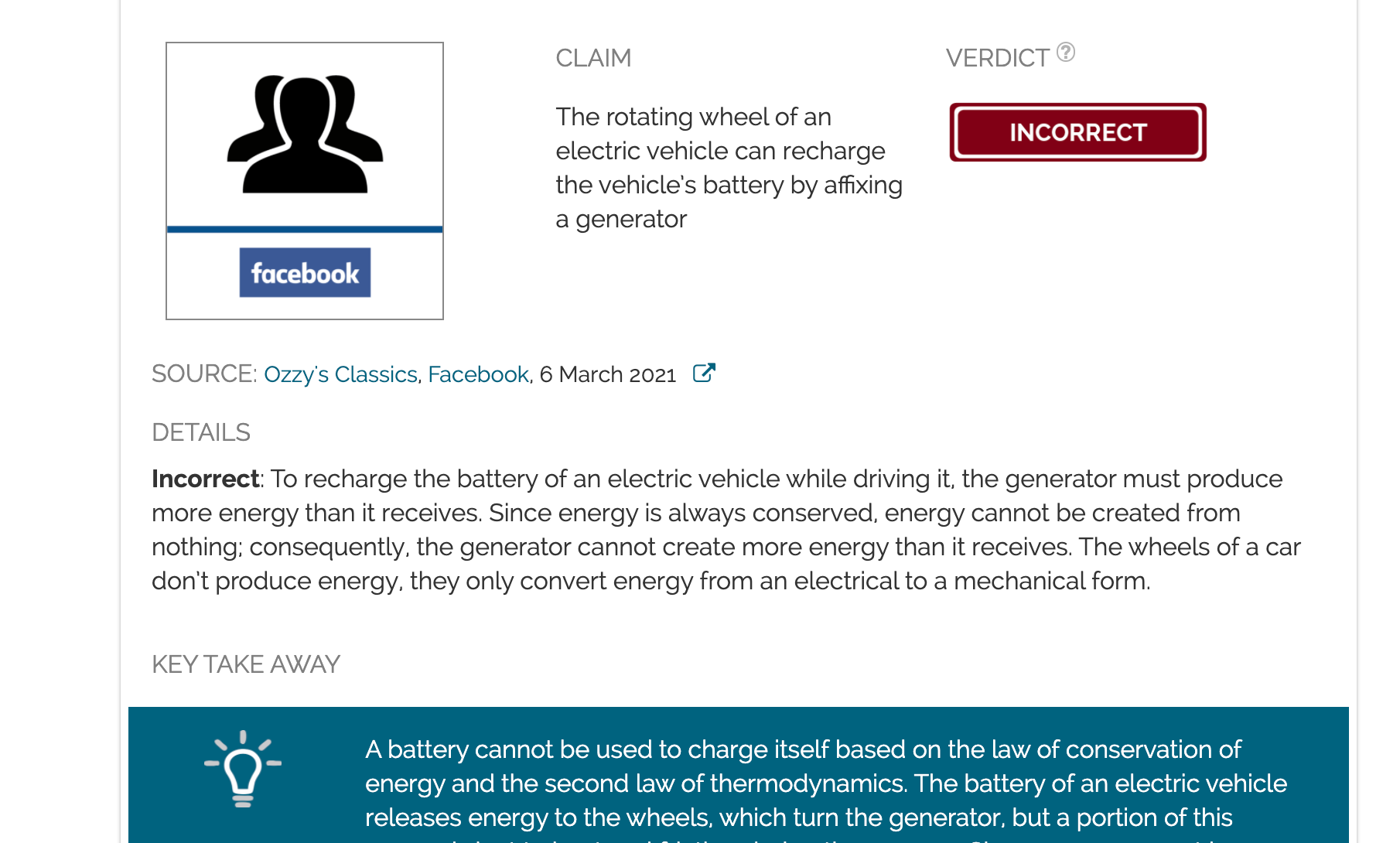- Energy
A "water-powered" car still requires other forms of fuel to work; it cannot run solely on water, contrary to viral Facebook video claims
Key takeaway
The "water-powered car" design relies on a chemical process known as electrolysis. In this design, water is split into its constituent elements, oxygen and hydrogen. The hydrogen generated from this reaction is then burnt to power the car. However, other forms of fuel are required to perform the electrolysis process. Therefore, a "water-powered car" cannot be powered solely by water and requires an actual fuel.
Reviewed content
Verdict detail
Inaccurate: The “water-powered” car design cannot run solely on water, as claimed. Fuel is required to kickstart the electrolysis reaction that splits water into hydrogen and oxygen. It is the hydrogen gas produced from this reaction that is used to power the car.
Incorrect: The process of splitting water into hydrogen and oxygen requires a greater energy input than the amount of energy generated from burning the hydrogen produced, hence the video’s claim that the car’s energy output is higher than its input is inaccurate. Furthermore, extracting net energy from this total cycle is impossible according to the first and second laws of thermodynamics.
Full Claim
There exists a car that runs solely on water; in 1996 Stan Meyer demonstrated a water powered car; his device was unique in that the energy output was higher than its input
Review
The claim that a car exists that runs solely on water appeared in a Gaia article in January 2020 and was published in a Facebook video on 2 March 2021. The article and video refer to Stanley Meyer’s “water-powered” car design, which relies on a chemical process known as electrolysis to split water into its constituent elements, oxygen and hydrogen. The hydrogen generated from this reaction is then burnt to power the car[1]. Because electrolysis requires large amounts of energy, other forms of fuel are required to actually perform the process of splitting water molecules. Therefore, a “water-powered car” cannot be powered solely by water as it requires other forms of fuel. Furthermore, because fuel is required to perform the electrolysis process, the “water-powered car” design isn’t a “zero emissions” design, as claimed in the video.
The article and video also claimed that the car’s “energy output was higher than its input”. This is not possible, as Wai Cheng, a professor of mechanical engineering at Massachusetts Institute of Technology, explained in an article published by MIT’s School of Engineering: water molecules are very stable. As a result, the process of breaking water molecules into hydrogen and oxygen requires a higher energy input than output. A water-powered car design requires the necessary equipment to split a water molecule apart as well as separate tanks to isolate oxygen and hydrogen. A combustion system is also required to burn the hydrogen fuel.
Stanley Meyer’s “water-powered car” worked by splitting water via electrolysis but the design was not “revolutionary” as the video claimed, since scientists have known about electrolysis of water since the end of the 18th century.
The video also asserted that the local Ohio news, the BBC and the U.S. Patent Office “validated this claim”. However, this claim is misleading as these outlets don’t test designs. In addition, the claim that the car traveled from “Los Angeles to New York using just 22 U.S. gallons (83 liters) of water” was an estimate from Meyer that hasn’t been reproduced in an independent experiment.
In summary, while Meyer’s water-powered car design uses a real chemical process to split water molecules to produce hydrogen that can power the car, the video gives readers the inaccurate and misleading impression that the car runs solely on water. This isn’t true, as other forms of fuel are required to perform the electrolysis process. Hence a water-powered car requires a separate fuel source, apart from water, in order to work. Finally, the video’s claim that the car’s energy output is higher than its energy input is simply impossible, as it violates the first and second laws of thermodynamics.
REFERENCES:
- 1 – Acar et al. (2016) Review of photocatalytic water‐splitting methods for sustainable hydrogen production. International Journal of Energy Research.



